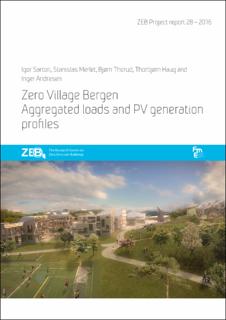| dc.description.abstract | The main findings can be summarized as follows:
•The aggregated annual thermal load is approximately the same as the electric load (3.3 GWh) for the entire Zero Village Bergen;
•The aggregated annual PV generation (2.9 GWh) covers ca. 90% of the electric load;
•Even so, PV peak generation (2.9 MW) is ca. 4 times higher than the electric peak load (0.7 MW) giving a GM2 of ca. 4;
•This implies that the local electric grid dimensioning capacity might be determined by the PV peak generation rather than by the peak load (depending on the choice of the thermal system and the expected load from electric vehicles, not considered here). The heating system for the Zero Village Bergen is not yet decided, since this will be the task in step three. However, the two most probable options on the design table are either an all-electric solution (with heat pumps in the buildings or at a local district heating station) or a thermal-carrier solution with a local district system (whether or not connected to the city district heating). The analysis of the energy balance and mismatch between loads and PV generation offers useful insights for the next step in the design phase:
•All-electric solution
If the thermal load is met by heat pumps the total electric load will be ca. 1/3 higher, assuming a seasonal COP of ca. 3 for the heat pump system, meaning that the ZEB-O target is not reached unless further generation (or load reduction) measures are considered3. The peak load can roughly be estimated at around 2 MW, giving a GM of ca. 1.5, and meaning that the local electric grid does not need to be largely over dimensioned due to the PV system. This might normally be regarded as a positive feature;
• Thermal-carrier solution
If the thermal load is met by a biomass based cogeneration system, this would provide at the same time a small additional load – counted in carbon emissions – and extra electricity generation, so that the overall ZEB-O goal may actually be reached. This will depend on the specific conversion factors used for biomass and electricity. The electric peak load would remain unchanged and so the GM. Having a high GM might not be a problem and may even be an advantage. It simply means that the dimensioning of the grid capacity is based on the PV peak generation in summer, while that capacity is free overnight year-round to be used for charging e-vehicles. | |
